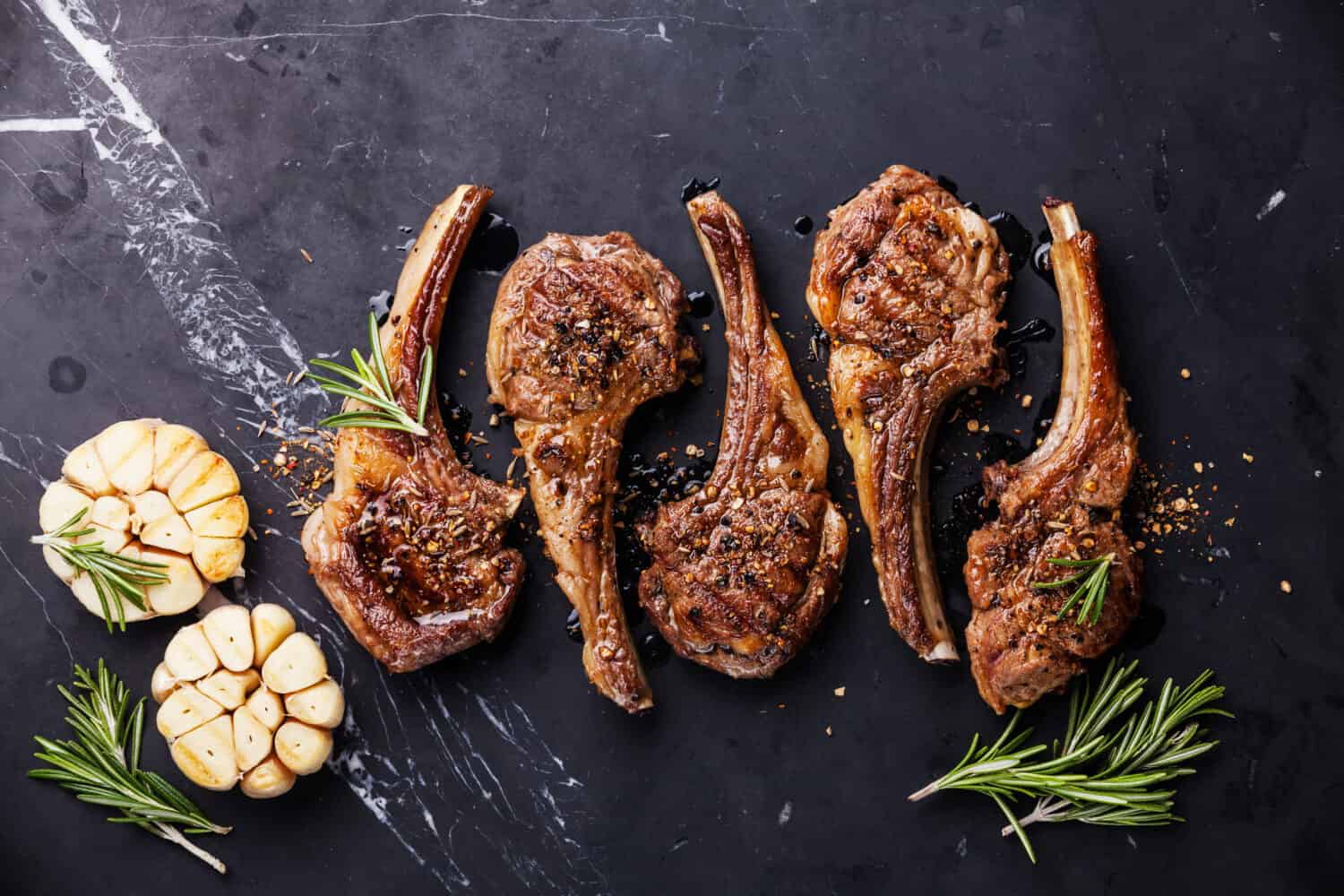Lamb meat and goat meat are becoming popular alternatives to beef. Both types of meat are widely consumed outside the U.S. but are fairly new to diners in the U.S. When it comes to lamb vs. goat, there are a few key differences that set them apart. The main differences between lamb and goat come down to flavor, texture, and nutritional value. Lamb is higher in fat with a white marbling giving the meat a richer texture and flavor. While goat meat is leaner and tougher. Goat has a hint of sweetness and a gamier flavor than lamb. And goat meat is higher in protein, while lamb meat is higher in fat.
Lamb vs. Goat: What is the Difference?
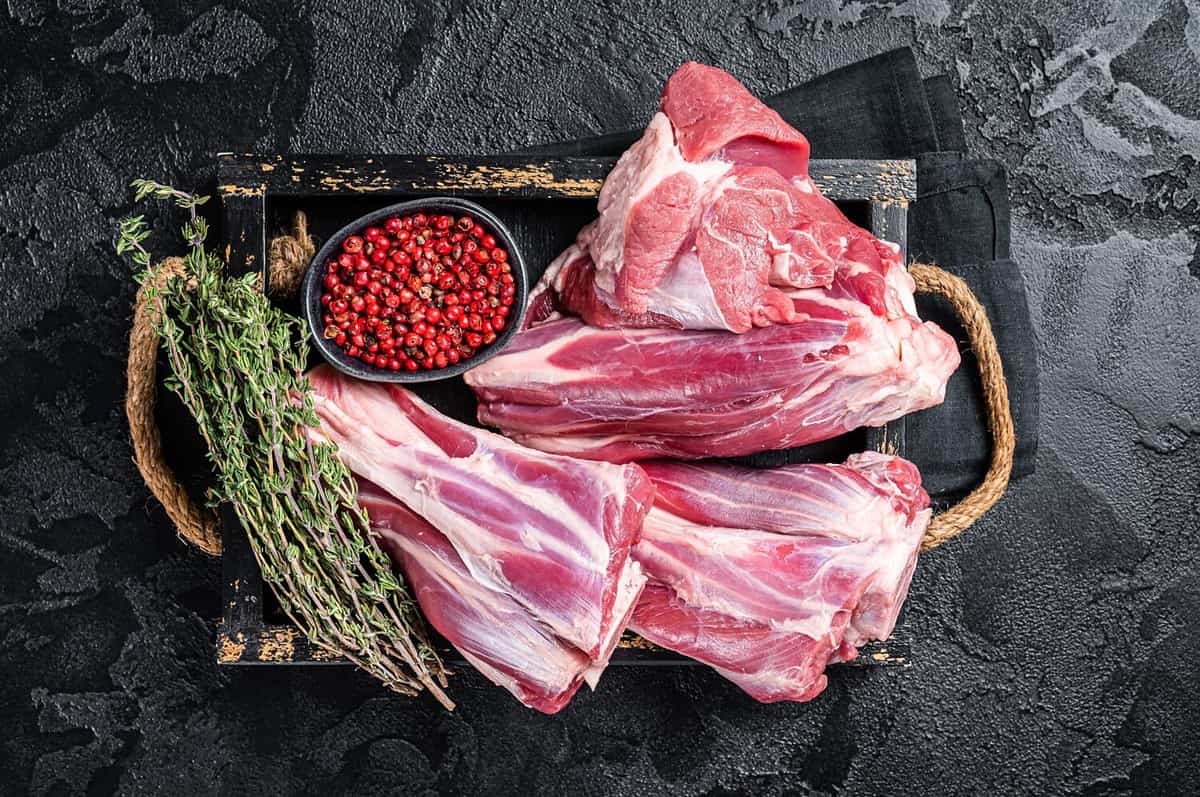
©Mironov Vladimir/Shutterstock.com
Lamb meat comes from sheep; the meat of young sheep is called lamb, and older sheep mutton. Goat meat comes from goats. Both of these four-legged animals have a similar diet and appearance, but their meats have nutritional differences that diners should understand when choosing one or the other. Lamb is a fattier meat with a softer texture, while goat is a lean meat with a tough and chewy texture.
Lamb vs. Goat: Nutritional Profile
According to Foodstruct, lamb has twice as many calories as goat and seven times more cholesterol and fat than goat meat. Goat meat is leaner and has a much higher protein content than lamb meat. Lamb has 25 grams of protein, while goat has 27 grams of protein. Goat meat is higher in iron, with 3.7 milligrams, while lamb only has 1.9 milligrams.
- The must-have convenient reference guide for every home cook!
- Includes more than 8,000 substitutions for ingredients, cookware, and techniques.
- Save time and money on by avoiding trips to grab that "missing" ingredient you don't really need.
When it comes to vitamins, lamb has more vitamins than goat. Lamb meat has vitamin D, vitamin B3, vitamin B6, vitamin B12, and vitamin K Goat meat has more vitamin E and B2. Lamb is lower in sodium but has higher levels of magnesium.
What is Lamb?
Lamb comes from sheep that are under one year old. There are different labels based on the age of the lamb. Milk lambs are 4-6 weeks old and have tender meat. Spring lambs are 3-5 months old and have less fat. A Ewe lamb is a female under one year, and a ram lamb is a male under one year. When a sheep is between one and two years old, they are referred to as a hogget. When the lamb is over the age of two years, the meat is called mutton.
Lamb meat is a tender red meat with a delicate flavor. It has a mild taste that is a mix of sweet and earthy. Lamb meat has white marbling because of its high-fat content and cooks tender and soft. The flavor is not overwhelming and is a suitable replacement for beef.
What is Goat?
Goats under one year of age are called capretto or cabrito. While older goats are called chevon. Goat meat has a stronger flavor with a tangy gaminess. The meat is bold and more intense than the taste of lamb. Goat meat is a lean red meat that is often tough and chewy.
Can You Substitute One for the Other?
While sheep and goats seem like similar animals and have similarities, their meat is distinctly different, and you can not substitute one for the other. The taste and texture are too different, and both meats benefit from specific cooking methods.
Best Ways to Cook Lamb
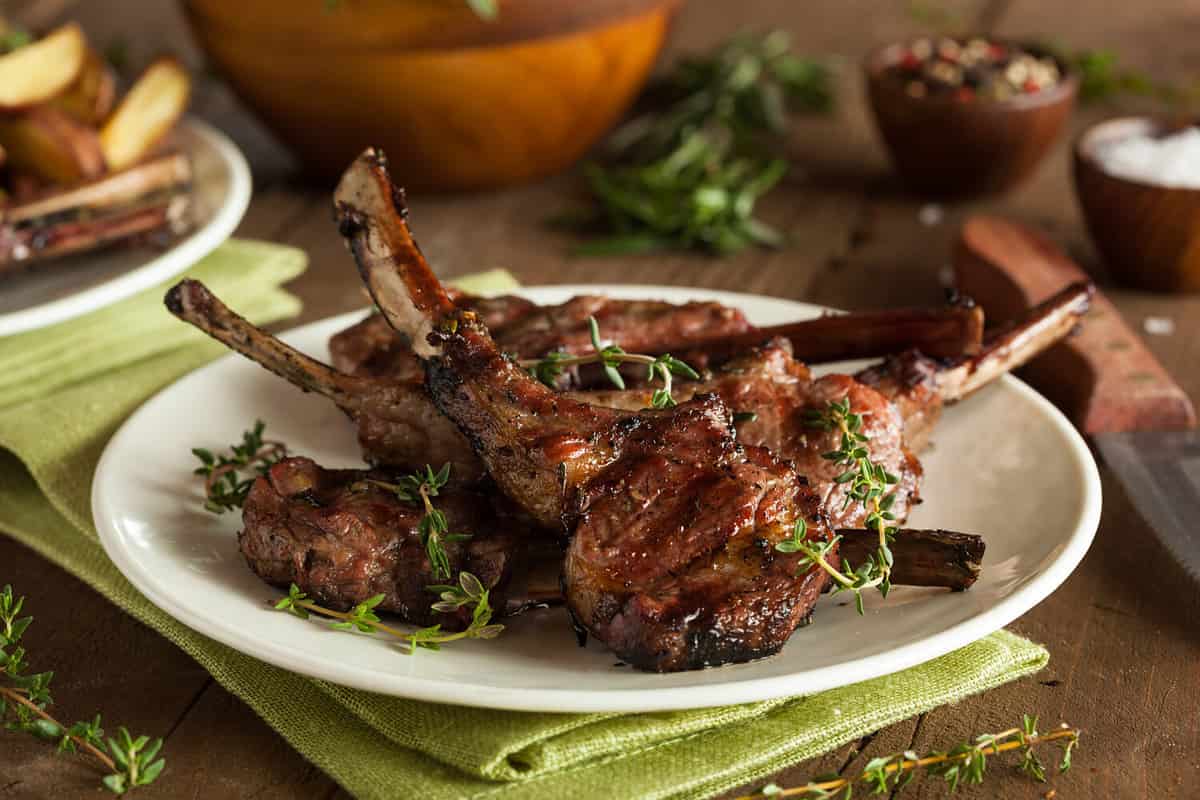
©Brent Hofacker/Shutterstock.com
Lamb can be grilled or roasted. The high-fat content keeps the meat tender, and the fat melts into the meat with every bite. Lamb meat can be used the same as beef. It can be ground and used in meatballs, burgers, or as tacos. Or cut into steaks, shanks, or chops and sautéed, baked, or grilled.
Lamb is a popular meat used in Mediterranean cuisine. In classic Greek dishes like moussaka and souvlaki, lamb meat is the star of the dish. Home chefs in Morroco use lamb meat in tagines and stews. In Turkey, lamb kebobs are a popular street food. In many parts of the world, an entire lamb is roasted for festivals and celebrations and shared within the community.
Best Ways to Cook Goat
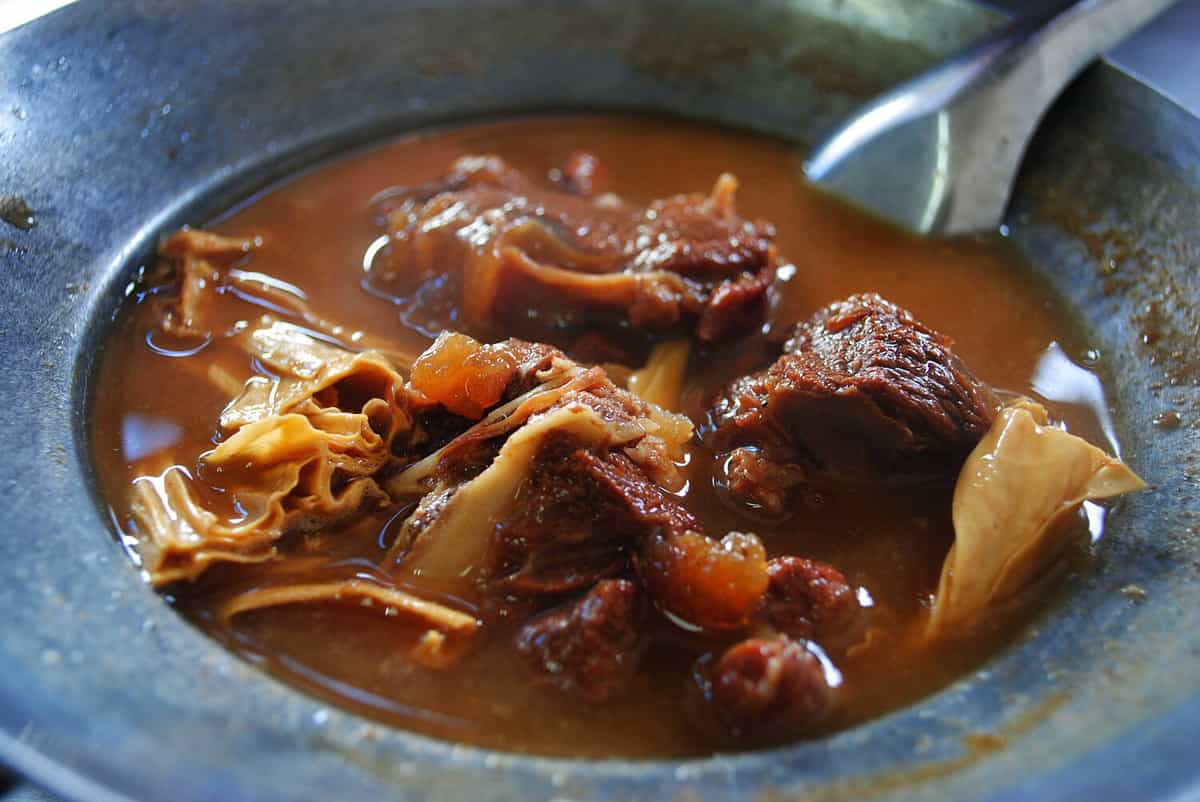
©tonfon/Shutterstock.com
Since goat meat is tougher, it should be cooked low and slow—braising, roasting, smoking, or in stews and curry. Goat meat needs a longer cooking time to allow the collagen in the meat to render. Goat meat should not be cooked at high temperatures because it will make this already tough meat even tougher.
- The must-have convenient reference guide for every home cook!
- Includes more than 8,000 substitutions for ingredients, cookware, and techniques.
- Save time and money on by avoiding trips to grab that "missing" ingredient you don't really need.
Eating goat meat is a way of life in many cultures. In the Caribbean, dishes like Jamaican curried goat and goat roti are popular. Goat meat is used in Africa in traditional stews, while in India and Pakistan, it is commonly used in curries and biryani. In some parts of Africa, goat meat is consumed as a special meal, a delicacy at festivals and weddings.
In Conclusion
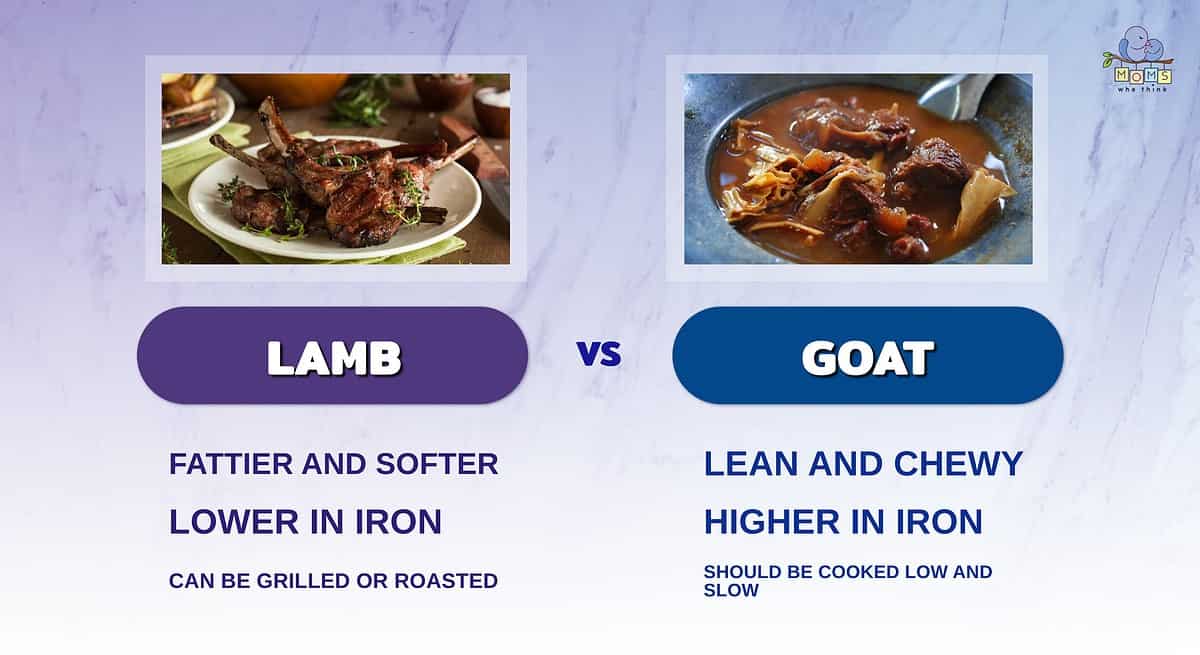
- Lamb's fattier and softer texture is a stark contrast to the lean and chewy texture of goat meat.
- Goat is a lot higher in iron than lamb, making it a good choice for those who may be iron deficient.
- Lamb can be grilled or roasted, while goat's tougher nature means it should be cooked low and slow. Smoking, braising, or throwing it in a stew are good options.
Lamb and goat meat are excellent choices for home chefs looking to try less common meats. Both are red meat and make an excellent alternative to beef. Choosing whether to use lamb or goat meat comes down to the dish. Goat meat must be slow-cooked, an excellent option for chilies, stews, soups, and curries. In comparison, lamb is a better alternative to replace beef in steaks, burgers, and barbecues.
Both lamb and goat meat are available in most supermarkets or butchers. Local ranches are another place to find lamb and goat meat too. Once you get some good lamb meat, give this lamb stew a go:
Print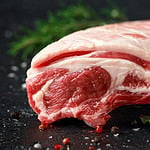
Lamb Stew
- Yield: Serves 4
Ingredients
1 1/2 pounds stewing lamb (be sure to look for the leanest possible cut)
all visible fat trimmed off, cut into 1 1/2 inch pieces
2 carrots, cut in 1- inch slices
2 medium onions, sliced
2 green peppers, sliced
2 large tomatoes, chopped (or canned tomatoes, drained, about 10 oz)
1 teaspoon seasoned salt (or to taste)
Black pepper to taste
Instructions
1. Quickly broil lamb pieces on all sides under broiler. Place in saucepan with vegetables and seasonings.
2. Cook, covered, over low heat one hour or until lamb is tender. If stew becomes dry, add a little tomato juice or bouillon while cooking.
The image featured at the top of this post is ©Natalia Lisovskaya/Shutterstock.com.
- The must-have convenient reference guide for every home cook!
- Includes more than 8,000 substitutions for ingredients, cookware, and techniques.
- Save time and money on by avoiding trips to grab that "missing" ingredient you don't really need.
